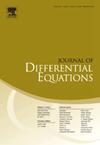The reflection coefficient of a fractional reflector
IF 2.3
2区 数学
Q1 MATHEMATICS
引用次数: 0
Abstract
This paper considers the question of characterizing the behavior of waves reflected by a fractional singularity of the wave speed profile, i.e., of the form for not necessarily integer. We first focus on the case of one spatial dimension and a harmonic time dependence. We define the reflection coefficient R from a limiting absorption principle. We provide an exact formula for R in terms of the solution to a Volterra equation. We obtain the asymptotic limit of this coefficient in the large regime as The amplitude is proportional to , and the phase rotation behavior is obtained from the factor. The proof method does not rely on representing the solution by special functions, since is general.
In the multi-dimensional layered case, we obtain a similar result where the nondimensional variable is modified to account for the angle of incidence. The asymptotic analysis now requires the waves to be non-glancing. The resulting reflection coefficient can now be interpreted as a Fourier multiplier of order −α.
In practice, the knowledge of the dependency of both the amplitude and the phase of R on ω and α might be able to inform the kind of signal processing needed to characterize the fractional nature of reflectors, for instance in geophysics.
分数反射器的反射系数
本文考虑了用波速剖面的分数奇点,即c(x1,x2,x3)=c0(1+(x1, r)+α)−1/2的形式来表征波的行为的问题,其中α>;0不一定是整数。我们首先关注一维空间和谐波时间依赖的情况。我们根据极限吸收原理定义了反射系数R。我们用Volterra方程的解给出了R的精确公式。我们得到了该系数在大r ω/c0区间的渐近极限asR=Γ(α+1)(2i)α+2(c0 r ω)α+低阶项。振幅与ω−α成正比,相位旋转行为由i−(α+2)因子获得。该证明方法不依赖于用特殊函数表示解,因为α>;0是一般的。在多维分层情况下,我们得到了类似的结果,其中修改了无因次变量r ω/c0以考虑入射角。渐近分析现在要求波是非掠射的。由此得到的反射系数现在可以解释为阶- α的傅里叶乘数。在实践中,关于R的振幅和相位对ω和α的依赖关系的知识,可能能够告知表征反射器分数性质所需的信号处理类型,例如在地球物理学中。
本文章由计算机程序翻译,如有差异,请以英文原文为准。
求助全文
约1分钟内获得全文
求助全文
来源期刊
CiteScore
4.40
自引率
8.30%
发文量
543
审稿时长
9 months
期刊介绍:
The Journal of Differential Equations is concerned with the theory and the application of differential equations. The articles published are addressed not only to mathematicians but also to those engineers, physicists, and other scientists for whom differential equations are valuable research tools.
Research Areas Include:
• Mathematical control theory
• Ordinary differential equations
• Partial differential equations
• Stochastic differential equations
• Topological dynamics
• Related topics

 求助内容:
求助内容: 应助结果提醒方式:
应助结果提醒方式:


